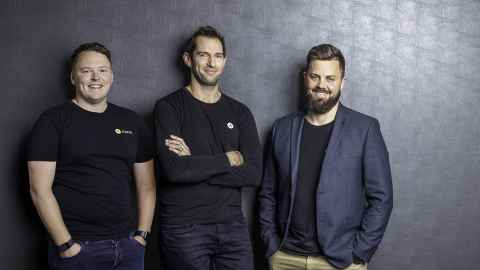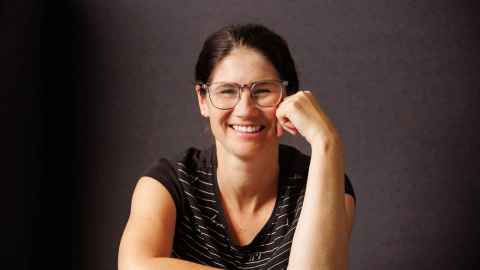A head for business
27 May 2024
A University entrepreneurship competition that has sparked some of New Zealand’s most exciting start-ups turns 21.

Kiwi tech company Auror is a name now known around the world, with its retail crime-fighting solutions used by more than 100,000 retailers and 2,500 law enforcement agencies globally.
In 2023, the firm was named New Zealand’s Supreme International Business and it has come a long way since it got its start at a University of Auckland programme just over a decade ago. For 21 years, the Centre for Innovation and Entrepreneurship’s (CIE) Velocity programme has been fostering an entrepreneurial mindset among students and staff at the University. Along the way, it has helped launch some of Aotearoa’s most groundbreaking start-ups – companies like Auror.
In fact, since inception, the centre has worked with 30,000 students and staff, and at the time of writing CIE alumni had raised $1.4 billion in capital and created 3,260 jobs, delivering products and services in 182 countries.
This success was recently recognised when Velocity won an award for best student engagement in the Asia-Pacific region from CASE, the Council for the Advancement and Support of Education.
For Darsel Keane, CIE’s director, the driving motivation for Velocity is both simple and extremely ambitious: “We want to cultivate the innovative and entrepreneurial talent that creates a better New Zealand and world.
“If you have an entrepreneurial mindset, when you see a problem, you respond in an entrepreneurial way to that – and what that typically means is that you delve deeply into problems, reframe them as opportunities and take action to solve them.”
It’s incredible looking back and seeing how much of the plan we created in that
programme still holds true.
At the heart of Velocity’s lofty goal is its $100k Challenge, a competition where budding entrepreneurs pitch their ideas for a chance to win cash prizes and a helping hand to turn their idea into reality. Each year, a handful of the best entrants are also invited to take part in CIE’s VentureLab – an intense half-year incubator programme designed to give participants the concrete skills needed to secure seed money and deliver their first product.
Auror was runner-up in the 2012 competition, and James Corbett, who co-founded the company along with Phil Thomson and Tom Batterbury, says the programme was “incredibly beneficial”. It allowed the trio to validate their idea and access mentors and experts to help them develop a business plan.
“It’s incredible looking back and seeing how much of the plan we created in that programme still holds true today,” says James, who was named on the University’s 40 Under 40 list in 2023.
Auror is one of many start-ups that got their break at CIE; centre alumni have started more than 276 ventures since 2003, and others include Zenno Astronautics, a space flight systems company, and Kami, an ed-tech firm named by Time magazine as one of the world’s most influential companies of 2022.
One reason CIE was so valuable, says James, is it “gave me real practice in thinking outside the box and testing ideas – a crucial skill when creating a business”.
Velocity – or Spark as it was initially called – was established in 2003 in the wake of Catching the Knowledge Wave, a 2001 conference where the country’s political and economic leaders of the time decided New Zealand needed to pivot away from its dependency on agricultural exports and become a high-value knowledge-based economy.

Originally a student-led initiative aimed at getting people on campus excited about entrepreneurship, the programme eventually led to the creation of an official university learning centre in 2009 with the birth of CIE.
And while the main focus of CIE is to help potential entrepreneurs like James turn their ideas into successful companies, another priority is to embed an entrepreneurial mindset in the University. Darsel believes cultivating this mindset will help turn more valuable university research into concrete business opportunities and prepare students for an increasingly uncertain job market.
In keeping with CIE’s overarching aim of using entrepreneurship to better society, Darsel also hopes the centre will equip more talented young problem solvers with the skills needed to tackle some of our big environmental and social challenges.
“If every single student leaves this University with an entrepreneurial mindset and capability, then I think that would be completely transformative for this country.”

STARTING FROM SCRATCH
Frustrated by constantly combing through her kids’ hair for nits, CIE alumna Kate Ricketts (above) founded a company that makes it easier for parents to get rid of lice eggs.
Her product, ISpy Nits Glo-Powder, is a hair powder that makes the critters’ eggs glow in the dark under a UV light. Not only does it make it easier for parents to get rid of latent eggs invisible to the naked eye, but it’s also a way of getting children excited about science.
Kate, who runs ISpy Nits while also working full-time at the University of Auckland as a Schools and Community Outreach Manager, says the idea to make nits glow in the dark came after she read an article on the potential of anti-theft powder to fluoresce insect exoskeletons. Having previously worked as a vet nurse, she remembered using a similar technique to search for ringworm in animals.
“I suddenly thought it might work on head lice. So I ordered some [anti-theft powder] off the internet and chucked it on my kid’s head – and it worked.”
After a bit of trial and error in her garage – using her two young boys as guinea pigs – Kate realised she was on to something.
Although nits can be treated with special shampoos (ISpy Lotion is included in the nit kits), if any eggs remain after treatment, the lice can quickly return. By coating and fluorescing the eggs, ISpy Nits Glo-Powder makes it easier for parents to find and remove any remaining eggs.
Kate says making nits glow in the dark changed everything for her children, particularly for her eldest child, who is neurodiverse.
“It reframed everything for my son because suddenly it was not ‘sit down so I can pull these out of your hair’, it was more like ‘hey, let’s look for glow-in-the-dark bugs’.”
Kate says CIE gave her the confidence and skills to turn her idea into a viable business. After making the final of the 2022 Velocity $100k Challenge, she won the social category and a place in CIE’s VentureLab, where she learnt about everything from intellectual property law to accessing seed money.
The company is also working with schools to remove the stigma around nits and to help use an outbreak as a learning opportunity, so children can learn about insect life cycles, for example, and the science behind biofluorescence.
This article first appeared in the Autumn 2024 edition of Ingenio.